Bathroom Readers' Institute's Blog, page 124
November 25, 2014
4 Fringe Benefits of “Thriller-Mania”
In 1984, Michael Jackson was so popular that LaToya Jackson scored a hit single.
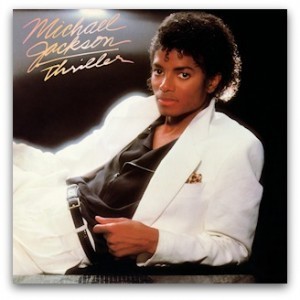 From 1982 to 1984, the American public couldn’t get enough Michael Jackson. His Thriller album sold more than 20 million copies to become the bestselling album ever. His innovative music videos helped put the burgeoning MTV on the map (and integrated the channel, too). Hundreds of thousands bought their own spangled white glove.
From 1982 to 1984, the American public couldn’t get enough Michael Jackson. His Thriller album sold more than 20 million copies to become the bestselling album ever. His innovative music videos helped put the burgeoning MTV on the map (and integrated the channel, too). Hundreds of thousands bought their own spangled white glove.
Six of the nine songs on Thriller were released as singles, and they all reached the top 10. But it wasn’t enough for record-buyers. The appetite for all things Jackson was so big that music by even his lesser-known siblings and associates struck it big.
Rebbie Jackson
Maureen “Rebbie” Jackson was the oldest of the nine Jackson siblings. In 1984, she released her first album, Centipede, and the title track went to #24 on the pop chart and #4 on the R&B chart. The album went gold.
LaToya Jackson
Before she became a tabloid fixture, LaToya Jackson had a music career. She didn’t want to capitalize on her famous name, however; she attempted to release her first album in 1980 as just “LaToya,” but her father/manager, Joe Jackson, wouldn’t allow that. But in 1984, “Heart Don’t Lie” became her first and only song to hit the pop chart, reaching #56. The video, however, earned heavy rotation on MTV.
Jermaine Jackson
Jermaine was a fairly big star in his own right, particularly on R&B radio. He’s had 20 hits on the R&B chart, but two of his biggest came after Thriller gave his career a boost: “Do What You Do,” and “When the Rain Begins to Fall,” a duet with Pia Zadora. (The bizarre video was also all over MTV at the time.)
Rockwell
In 1984, 20-year-old Kenneth Gordy landed a record deal with Motown Records…a company that just so happened to be founded, owned, and run by his father, Berry Gordy. Under the stage name Rockwell, his first single “Somebody’s Watching Me” was a #2 smash hit. But that is almost all because of Michael Jackson. With its themes of ghosts and the occult, the song is quite similar to “Thriller.” Jackson, a former Motown act, sang the song’s hook uncredited, but there’s no mistaking it’s him.
_____________________________________
Want more astounding facts and fascinating trivia?
Our annual holiday sale is happening now.
The post 4 Fringe Benefits of “Thriller-Mania” appeared first on .
November 24, 2014
Thanksgiving Down at Alice’s Restaurant
On Thanksgiving Day 1965, folk singer Arlo Guthrie decided to help his friend Alice get rid of some trash. What happened next would go on to inspire a hit film and one of the biggest anti-war anthems of the ‘60s.
In late 1964, Alice M. Brock and her husband bought an old church in Massachusetts and turned it into their home. The next Thanksgiving, they had some friends over for dinner. Among them was the folk singer Arlo Guthrie, son of the legendary Woody Guthrie. In return for Alice’s hospitality, he and another guest agreed to haul away their garbage.
Overlooking or forgetting the fact that it was Thanksgiving, the two drove to the nearest dump, which was closed for the holiday. Undaunted, they decided to get rid of the garbage in a nearby ravine. They were quickly arrested by a local police officer named William “Obie” Obanhein. Obanhein photographed them in the act but he had a surprise waiting for him two days later when Guthrie and his partner in crime went to court to face the charges. The blind judge arrived with a seeing-eye dog and couldn’t actually look at the photos. He gave the two culprits a fine and told them to never litter again.
This charge would later help Guthrie avoid getting drafted into the Vietnam War. During a trip to an induction center in New York City, the singer did his best to come up with any excuse to get out of military service. After pleading insanity and bombing the physical exam, the recruiters decided not to draft him because of his “criminal history” as a litterbug.
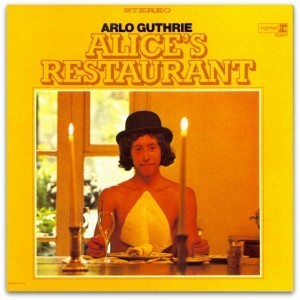 Guthrie later wrote and recorded “Alice’s Restaurant Massacree,” an 18-minute “musical monologue” inspired by these incidents. It was featured on his 1967 album, Alice’s Restaurant, which reached at #17 on Billboard’s album chart. The song was never a hit single, but it struck a chord with the anti-war movement. Weirdly enough, supposedly Richard Nixon owned a copy of the album—Guthrie later joked that the infamous missing gap in the Nixon White House Tapes had the same running time as the song.
Guthrie later wrote and recorded “Alice’s Restaurant Massacree,” an 18-minute “musical monologue” inspired by these incidents. It was featured on his 1967 album, Alice’s Restaurant, which reached at #17 on Billboard’s album chart. The song was never a hit single, but it struck a chord with the anti-war movement. Weirdly enough, supposedly Richard Nixon owned a copy of the album—Guthrie later joked that the infamous missing gap in the Nixon White House Tapes had the same running time as the song.
Broadcasting the song became a Thanksgiving tradition on rock radio stations around the country and some of them still break it out every Turkey Day. It was so popular that a film version titled Alice’s Restaurant, starring Guthrie, was released in 1969. The producers even managed to convince Obanhein to play himself. The police officer later told the press that he accepted the role because he wanted to make a fool out of himself rather than let someone else have the honor.
_____________________________________
Want more astounding facts and fascinating trivia?
Our annual holiday sale is happening now.
The post Thanksgiving Down at Alice’s Restaurant appeared first on .
The 6 Worst Season-Starting Losing Streaks In Pro Sports History
The phrase “off to a good start” did not apply to these teams.
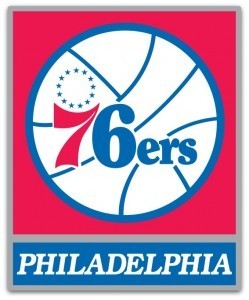 As of this writing, the Philadelphia 76ers have lost the first 13 games of their NBA season. (Many NBA teams, albeit ones having really good seasons, have lost that same number of games over an entire season.) How bad are the 76ers? Philadelphia-area Papa John’s locations offered 50 percent off of online orders the day after the 76ers won a game, but after the Sixers lost their 11th game, the company made the offer good if the team scored more than 90 points, regardless of if they win or lose.
As of this writing, the Philadelphia 76ers have lost the first 13 games of their NBA season. (Many NBA teams, albeit ones having really good seasons, have lost that same number of games over an entire season.) How bad are the 76ers? Philadelphia-area Papa John’s locations offered 50 percent off of online orders the day after the 76ers won a game, but after the Sixers lost their 11th game, the company made the offer good if the team scored more than 90 points, regardless of if they win or lose.That’s still not the worst season-beginning losing streak in the annals of basketball. The 2009-2010 New Jersey Nets started its season with 18 straight losses. And both the 1988-89 Miami Heat (in its first year of existence) and the 1998-99 Los Angeles Clippers both lost 17 games before securing a win.
The Oakland Raiders finished up the 2013 NFL season with a six-game losing streak. And when the 2014 season began, they kept losing. The Raiders lost their first 10 games of the season—a 16 game losing streak. The Raiders jumped to a 1-10 record with a 24-20 win against the Kansas City Chiefs on November 20, the team’s first win in over a year.
The Tampa Bay Buccaneers began play in the NFL in 1976. Expansion teams almost always have terrible first seasons as they adjust, but the Bucs had the worst one: 0-14. In the 1977 season, things didn’t go much better, as the team lost its first 12 games of the 1977 season. The first win in franchise history came on December 11, 1977 with a win over the Saints, ending an inaugural 26-game losing streak.
The 1988 Baltimore Orioles posted one of the worst overall records in Major League Baseball history: 54 wins and 107 losses. A small portion of those losses came at the beginning of the season: The Orioles posted an initial record of 0-21.
_____________________________________
Want more astounding facts and fascinating trivia?
Our annual holiday sale is happening now.
The post The 6 Worst Season-Starting Losing Streaks In Pro Sports History appeared first on .
November 20, 2014
6 Fruits and Vegetables That Aren’t What They Seem
Prepare to have your world turned upside-down.
 Watermelon
WatermelonBerries aren’t necessarily small. Technically speaking, a berry is a subset of fruit in which multiple viable seeds of the fruit are embedded and scattered throughout its edible flesh. This means that the massive watermelon, with its little black and white seeds spread throughout its pink flesh, is technically speaking, a berry.
Strawberries, raspberries, blackberries
Oddly enough, these three fruits that actually have the word “berry” in their names…aren’t really berries. A strawberry is an enlarged end of a stem, embedded on the outside with seeds. The same is true for raspberries and blackberries. Seeds on the outside means they aren’t berries.
Chili peppers
Like a watermelon, its seeds are spread throughout. A chili pepper is a berry.
Avocadoes
Fruits don’t have to be sweet. The tomato is technically a fruit because it is the fleshy product of a plant that contains seeds and is edible. The same is true for avocadoes, which means that guacamole is really just a fruit salad (or even a smoothie).
Vegetables
While fruit has a very specific definition, what makes a vegetable is up for debate. It’s generally thought of as anything plant-based that can be eaten, and at least in the West, isn’t terribly sweet.
Carrots
Carrots are among the sweetest “vegetables,” but the one thing everyone thinks they know about carrots isn’t true. They are healthy (they’re especially rich in vitamin A) but they really don’t improve eyesight. During World War II, the Royal Air Force was using radar to find Nazi war planes, but they didn’t want the Nazis to know that. So, the British government spread a bit of propaganda claiming that fighter pilot John Cunningham had 20/20 vision, even at night, because he ate lots of carrots. (It also led to much more enthusiastic eating of carrots grown in “Victory Gardens.”)
_____________________________________
Want more astounding facts and fascinating trivia?
Our annual holiday sale is happening now.
The post 6 Fruits and Vegetables That Aren’t What They Seem appeared first on .
November 18, 2014
Did You Care About “Voices That Care”?
As “Do They Know It’s Christmas?” makes a comeback , here’s a look back at a less famous all-star charity single.
 In 1984, British rock star Bob Geldof saw a TV documentary about the African famine and was inspired to act. He recruited dozens of A-list British and Irish musicians (Sting, Bono of U2, George Michael, Paul Young, to name a few) and wrote and recorded under the name Band Aid, “Do They Know It’s Christmas?” It became one of the bestselling singles ever in the U.K., and generated millions for famine relief.
In 1984, British rock star Bob Geldof saw a TV documentary about the African famine and was inspired to act. He recruited dozens of A-list British and Irish musicians (Sting, Bono of U2, George Michael, Paul Young, to name a few) and wrote and recorded under the name Band Aid, “Do They Know It’s Christmas?” It became one of the bestselling singles ever in the U.K., and generated millions for famine relief.
The next year, American musicians would unite for the same cause in a similar way, as USA For Africa, with the song “We Are the World.” That one was a huge, success, too. From then on, it seems like any time there has been a major tragedy or social ill, musicians have united for a charity single. In 1991, a one-off supergroup called Voices That Care was formed to show that it, uh, cared, about the troops going off to fight in the first Desert Storm conflict in Iraq.
Voices That Care was put together by David Foster, the Canadian songwriter/producer best known for turning the jazz-rock fusion band Chicago into a soft rock hit machine in the ‘80s; and Peter Cetera, the lead singer of Chicago. They wrote the song together and got a who’s who of early 1990s star to chip in. Some of the voices that cared:
Michael Bolton
The Fresh Prince
Nelson
Bobby Brown
Garth Brooks
Katthy Mattea
Kenny G (playing saxophone)
Luther Vandross
Jani Lane of hair-metal band Warrant
This one didn’t hit become a cultural phenomenon like “Do They Know It’s Christmas” or “We Are the World.” First of all, both of those songs had a clearly defined, apolitical cause: to generate money to help feed starving people in Africa. “Voices That Care” was a vague message of “support” to troops fighting in a war of which public opinion was very much divided.
And also, by the time the song was recorded, the video made, and the single released in late February 1991, the war with Iraq was over after just six weeks. “Voices That Care” peaked at #11 on the pop chart.
_____________________________________
Want more astounding facts and fascinating trivia?
Our annual holiday sale is happening now.
The post Did You Care About “Voices That Care”? appeared first on .
5 Weird Brady Bunch Spinoffs
It was not a “sunshine day” for these ill-fated continuations of America’s most enduring sitcom. Here are the Brady Bunch spinoffs that didn’t experience the same level of success as the original show.
 The Brady Bunch was not a massive hit when it first aired from 1969 to 1974. It never hit the Nielsen Top 30, but it did resonate with kids and teenagers. That cult appeal made it a favorite in reruns, where it’s never stopped airing somewhere in the U.S. It’s been so popular after the fact that the show has spawned a number of spinoffs…and almost all of them are way weirder than the fact that six Brady kids shared one bathroom that didn’t even have a toilet.
The Brady Bunch was not a massive hit when it first aired from 1969 to 1974. It never hit the Nielsen Top 30, but it did resonate with kids and teenagers. That cult appeal made it a favorite in reruns, where it’s never stopped airing somewhere in the U.S. It’s been so popular after the fact that the show has spawned a number of spinoffs…and almost all of them are way weirder than the fact that six Brady kids shared one bathroom that didn’t even have a toilet.
The Brady Kids
All six Brady child actors provided their own voices for this bizarre Saturday morning cartoon show. The parents and Alice were gone, but assisting the Bradys in their adventures through space and time (literally) were a talking bird named Marlon, a talking dog named Mop Top, and pandas named Ping and Pong. It aired for over a year (1972-73).
The Brady Bunch Hour
A garish, glitzy, star-studded 1970s-style variety show…hosted by the cast of The Brady Bunch…in character. (Well, almost everyone. Eve Plumb refused to reprise her role as Jan and was replaced with another actress.) A swimming pool was the centerpiece of the set, and not so surprisingly, a Brady ended up in that pool in every episode.
The Brady Brides
After huge ratings for a 1981 TV movie called The Brady Girls Get Married, in which Jan and Marcia marry their boyfriends in a double wedding at home, ABC commissioned this series. Jan and Marcia, and their husbands, all lived in one house together because they couldn’t afford to live separately. It lasted only six episodes.
The Bradys
In 1990, CBS debuted The Bradys—a serious drama about the six Brady kids all grown up, with shockingly serious problems. For example, Bobby had been paralyzed in a car accident, Peter is in an abusive relationship, Jan and her husband can’t conceive a baby, and Marcia has a drinking problem. It was cancelled after just six episodes.
The Brady Bunch in the White House
After two ironic, tongue-in-cheek theatrical Brady movies, the third film entry aired on Fox over Thanksgiving weekend in 2002. Mike Brady (Gary Cole) tries to return a winning lottery ticket to its rightful owner, a death row inmate. His honesty impresses the president of the United States, who asks Mike to be his running mate. After the corrupt president resigns…Mike Brady becomes the most powerful man in the free world.
_____________________________________
Want more astounding facts and fascinating trivia?
Our annual holiday sale is happening now.
The post 5 Weird Brady Bunch Spinoffs appeared first on .
November 17, 2014
What’s a Blue Raspberry?
Believe it or not, it’s a real fruit, not a lab creation. Well, sort of.
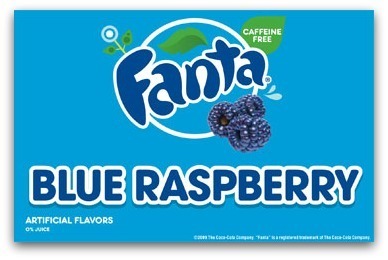 In response to the horrific conditions of food processing plants exposed in books like Upton Sinclar’s The Jungle, the federal government passed the Pure Food and Drug Act in 1906. It allowed only seven food dyes to be used by American food makers, including FD&C Orange No. 1. No harm was reported until the early 1950s, when it was discovered that a handful of children had gotten sick after eating foods that contained the dye. Orange 1 was banned by the FDA in 1956, leading the FDA to thoroughly retest food dyes and additives. One of the dyes tested was FD&C Red No. 2, which the agency recognized as safe, although only provisionally.
In response to the horrific conditions of food processing plants exposed in books like Upton Sinclar’s The Jungle, the federal government passed the Pure Food and Drug Act in 1906. It allowed only seven food dyes to be used by American food makers, including FD&C Orange No. 1. No harm was reported until the early 1950s, when it was discovered that a handful of children had gotten sick after eating foods that contained the dye. Orange 1 was banned by the FDA in 1956, leading the FDA to thoroughly retest food dyes and additives. One of the dyes tested was FD&C Red No. 2, which the agency recognized as safe, although only provisionally.
But there were reports of that dye, made from coal tar or petroleum byproducts, leading to seizures or, according to a 1971 study in the Soviet Union, cancer. It was still very widely used, with a million pounds of the dye used each year in the U.S. by 1976…the year the FDA banned it as a carcinogen.
The removal of that particular dye from commercial use caused havoc for ice-pop manufacturers. What are ice-pops? They’re those popsicle-like treats packaged in thin plastic tubes that are sold as liquid and customers are to freeze themselves. Ice pops—brands like Fla-Vor-Ice and Otter Pops—are a mixture of water, sugar, artificial flavor, and dyes.
Different red dyes were used to indicate flavor—orange for orange, and green for lime, for example. It was trickier with red fruits. A box of Otter Pops contained cherry, strawberry, watermelon, and raspberry treats, all requiring a different shade of red. Manufacturers ultimately decided to make cherry a dark red, strawberry a light red, watermelon a light pink, and raspberry a very dark red. But the dye used for raspberry-flavored food items at the time? The banned Red No. 2.
Food processors didn’t know what to do—it wasn’t worth it making yet another shade of red for an already crowded field of red products. That’s when some food scientists discovered blue raspberry. Yes, it’s a real flavor. Scientists took the flavor from the Whitebark Raspberry, which bears a blackish-bluish fruit, with a rarely used blue food dye called FD&C Blue No. 1.
“Blue raspberry” was born. Today, it’s a food industry standard. You can find “blue raspberry” flavors of everything from Jolly Ranchers to yogurt to bubble bum to Gatorade.
_____________________________________
Want more astounding facts and fascinating trivia?
Our annual holiday sale is happening now.
The post What’s a Blue Raspberry? appeared first on .
Bo Knows…Company
Bo Jackson famously played both professional football and baseball in the 1980s and 1990s. Here are some other athletes who played more than one sport.
 Danny Ainge is an executive with the Boston Celtics for whom he played the first eight seasons (1981-1989) of a 15-year NBA career in which he won two championships and played on two All-Star teams. But all of that came after Ainge’s baseball career. Drafted in 1977 by the Toronto Blue Jays (in the team’s first year of existence), he played 211 games over three seasons, hitting a respectable .264. When he decided to pursue basketball, he was drafted by the Celtics in 1981, who had to buy out his contract from the Blue Jays, one of the few times a team from one sport had to pay off a team in another sport.
Danny Ainge is an executive with the Boston Celtics for whom he played the first eight seasons (1981-1989) of a 15-year NBA career in which he won two championships and played on two All-Star teams. But all of that came after Ainge’s baseball career. Drafted in 1977 by the Toronto Blue Jays (in the team’s first year of existence), he played 211 games over three seasons, hitting a respectable .264. When he decided to pursue basketball, he was drafted by the Celtics in 1981, who had to buy out his contract from the Blue Jays, one of the few times a team from one sport had to pay off a team in another sport.In 2004 ESPN named Dave Winfield one of the best all-around athletes of all time, regardless of sport. He’s in the Baseball Hall of Fame, but might have been in another hall, had he made a different decision. He led the University of Minnesota to a conference championship in basketball in 1972, which led to his being drafted by the Atlanta Hawks of the NBA and the Utah Stars of the ABA. He was so dominant an athlete in Minnesota that the Minnesota Vikings of the NFL drafted him, too, even though he didn’t play college football. He ultimately went with baseball, and the team that drafted him—the San Diego Padres. Winfield went into the majors not as the power hitter he became…but as a pitcher.
Wilt Chamblerlain is one of the best basketball players to ever take the court. After his NBA career ended in 1973, the 7’1” star switched sports to volleyball, playing five years for the Seattle Smashers of the International Volleyball Association.
In 1950, Sweetwater Clifton helped break the NBA’s color barrier—he was the second African-American, after Earl Lloyd, to play in the league. Already a seasoned 27 by the time he signed with the New York Knicks, he had already put in time barnstorming with the Harlem Globetrotters in basketball, and barnstorming in baseball with the New York Rens, an all-black team.
Walter Ray Williams is good at throwing heavy objects. He’s one of the most dominant professional bowlers of all time, earning 47 Professional Bowlers Association tournament wins, including eight majors, three World Championships, and nine PBA Senior Tour victories. He’s also a six-time winner of the Men’s World Horseshoe Pitching championship.
_____________________________________
Want more astounding facts and fascinating trivia?
Our annual holiday sale is happening now.
The post Bo Knows…Company appeared first on .
November 14, 2014
Primetime in East Germany
This month marks the 25th anniversary of the fall of the Berlin Wall, which was a major step towards the eventual reunification of Germany in 1990. These landmark events helped make life (and TV) a lot better for half of the country. Here are a few East German TV shows from behind the Iron Curtain.
Government officials in East Germany hated that many TV stations from West Germany could be viewed by their citizens. Over the years, they employed a variety of methods to discourage or prevent these “subversive” western broadcasts from being viewed across the border. They considered jamming the airwaves and even encouraged members of the country’s youth movement to damage any TV antennas they spotted pointing west. When their various schemes proved ineffective, the government debuted Der Schwarze Kanal (“The Black Channel”) in 1961. This weekly propaganda program typically consisted of western broadcasts re-edited with Communist commentary by host Karl-Eduard von Schnitzler. Der Schwarze Kanal was incredibly unpopular and a widely circulated urban myth claimed that a power surge was once caused by a bunch of East Germans all turning off their TV sets one night as the show began. Nevertheless, it stayed on the air for over 30 years. Der Schwarze Kanal’s last episode was broadcast mere days before the fall of the Berlin Wall.
Unser Sandmännchen
Every night at 6:50, this children’s show aired on one of East Germany’s state-run television stations. Hosted by an adorable stop-motion puppet named Sandmännchen (“The Little Sandman”), an average episode ran about 10 minutes and featured a family-friendly story. Afterward, Sandmännchen would wish all the kids at home “good night” and urge them to go to bed….even though it was barely 7 p.m. The character was beloved by multiple generations of East Germans and aired for decades, even after the country’s reunification; there was even a Western German version of the show.
Ein Kessel Buntes
This somewhat strange variety program was broadcast from 1972 to 1992. Unlike many of East Germany’s TV shows, it was noted for its somewhat high production values. Among other things, it actually aired in color (the title means “A Kettle of Color” in English), in order to compete with similar shows drifting over from West Germany. The program was never as popular as its western competitors, but the show’s producers did manage to convince an up and coming Swedish band called ABBA to perform on a 1974 episode.
_____________________________________
Want more astounding facts and fascinating trivia?
Our annual holiday sale is happening now.
The post Primetime in East Germany appeared first on .
November 11, 2014
A Simple, Humble President
Get to know one of the quirkiest heads of state in the world: Jose Mujicam, the President of Uruguay.
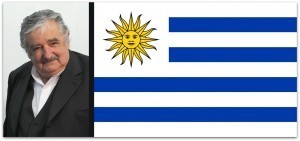 When he was about 30 in the mid-1960s, Jose Mujica joined the MLB-Tupamaros, a left-wing guerrilla group in his native Uruguay formed to take down the government of president Jorge Pacheco Areco, who suspended civil liberties and instituted economic freezes. For his role in raids and captures on towns, Mujica eventually and in total served 13 years in prison, two of it in solitary confinement. He was freed in 1985 and got into politics, joining the Uruguayan senate (as a moderate) in 1994. He was elected president of Uruguay in 2009.
When he was about 30 in the mid-1960s, Jose Mujica joined the MLB-Tupamaros, a left-wing guerrilla group in his native Uruguay formed to take down the government of president Jorge Pacheco Areco, who suspended civil liberties and instituted economic freezes. For his role in raids and captures on towns, Mujica eventually and in total served 13 years in prison, two of it in solitary confinement. He was freed in 1985 and got into politics, joining the Uruguayan senate (as a moderate) in 1994. He was elected president of Uruguay in 2009.As one of his first acts as president, Mujica instituted an overhaul of laws that led to the legalization of marijuana. That allowed federal resources to be redirected to fighting the influx of harder drugs from neighboring Paraguay.
While he’s now president, and more moderate, Mujica still identifies as the same common man he was when he was a guerrilla. For example, he chooses not to live in the country’s official residence, but in a small, rundown farm on the outskirts of the national capital of Montevideo owned by his wife. Roughly 75 percent of his $11,000 monthly salary he donates to charity.
Mujica claims his only “real” possession is his 1987 Volkswagen Beetle. He doesn’t hold on to it out of sentimental attachment (which he doesn’t really believe in), only because he needed something to drive around Manuela, his three-legged dog.
A sheikh reportedly offered Mujica $1 million for the car. He hasn’t decided if he’ll sell yet, but if he does, he’s promised he’ll donate the money to a government program that builds houses for the homeless.
_____________________________________
Want more astounding facts and fascinating trivia?
Our annual holiday sale is happening now.
The post A Simple, Humble President appeared first on .





